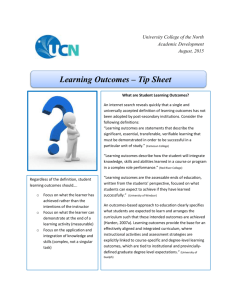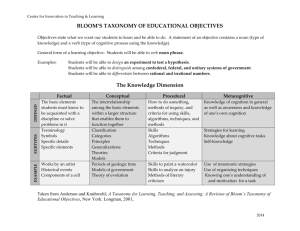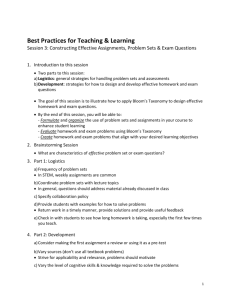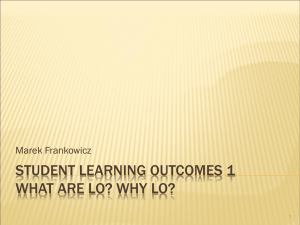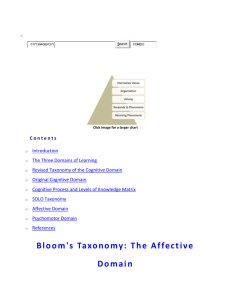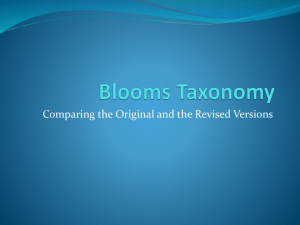Presentation - George Washington School of Medicine and Health
advertisement
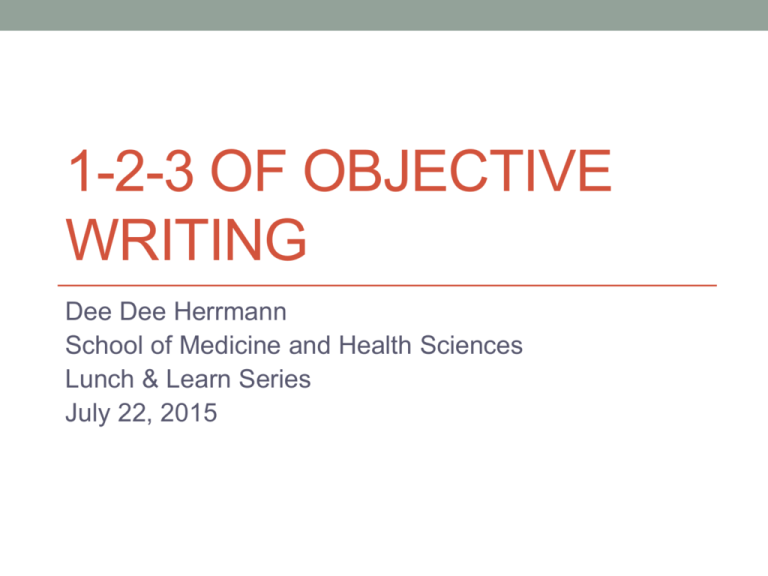
1-2-3 OF OBJECTIVE WRITING Dee Dee Herrmann School of Medicine and Health Sciences Lunch & Learn Series July 22, 2015 Acknowledgement • Special thanks to Ellen Goldman, Ed.D. for developing this 3 step process for objective writing, teaching it to me and many others in Master Teacher Leadership Development program, and giving me permission to share it with my Health Science colleagues. Learning Objective • Definition: • A clear, concise, specific statement of observable student behavior that can be evaluated at the conclusion of a learning event. • Is not the same thing as a course goal, but serves the course goals by defining the steps students will take along the way to achieving the goal. Steps to Developing Learning Objectives 1. Review your session or course goals. Think about where you are trying to move the student from and where you would like them to end up. 2. Ask yourself which knowledge or skills you want the learners to acquire and demonstrate through participation in this session. Consider the “cognitive processing dimension” which you would like the learner to achieve. Do they need to be able to define a concept, demonstrate a psychomotor skill, or evaluate a complex process? 3. Describe the one expected learner performance or outcome in measurable terms using action words from Bloom’s taxonomy. 4. Use a teaching strategy which matches the cognitive processing dimension on Bloom’s taxonomy. Before You Write Any Objectives Review your session or course goals. Think about where you are trying to move the student from and where you would like them to end up. • Ex: The goal of this course is teach students with minimal medical experience to safely perform common clinical procedures used in the Emergency Department. Step 1 Ask yourself which knowledge or skills you want the learners to acquire and demonstrate through participation in this session. Consider the “cognitive processing dimension” which you would like the learner to achieve. Do they need to be able to define a concept, demonstrate a psychomotor skill, or evaluate a complex process? • Ex: I would like the students to be able to properly perform a lumbar puncture Step 2 Describe the one expected learner performance or outcome in measurable terms using action words from Bloom’s taxonomy per learning objective. • “At the end of the session, the student will be able to …” • Explain the indications and contraindications for performing lumbar puncture • Demonstrate the proper technique for passing the spinal needle into the intrathecal space • Analyze the results of CSF blood counts to determine diagnosis Step 3 Use a teaching strategy which matches the cognitive processing dimension on Bloom’s taxonomy. • Ex: A session on LPs with the above learning objectives likely will include: • Discussion of indications / contraindications (Comprehension) • Demonstration and practice of LP technique (Application) • Various CSF “problem sets” for students to work through (Analysis) “Understand” “Learn” “Appreciate” Time to Vote! #1 At the end of the session, the students will be able to list the common presenting symptoms of colon cancer and discuss indications for diagnostic colonoscopy. #2 At the end of the session, students will have changed their minds regarding the causes of homelessness. #3 At the end of the session, students will be able to perform cannulation of a peripheral vein on a model. #4 At the end of the session students will understand the etiology of breast cancer. #5 At the end of the session, students will be able to compare and contrast the pathological changes in Crohn’s disease vs. Ulcerative Colitis LET’S TRY IT

